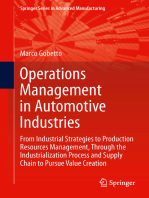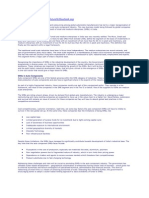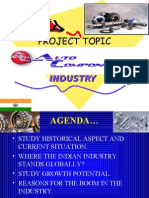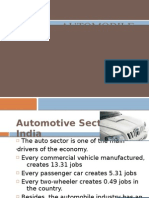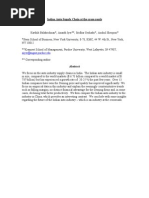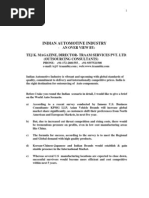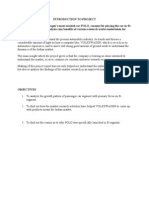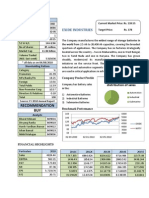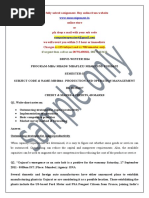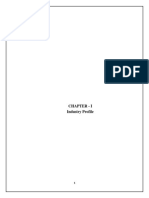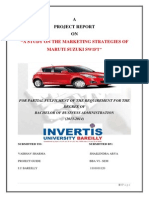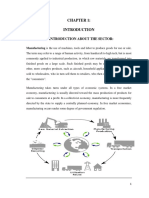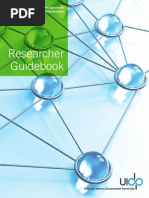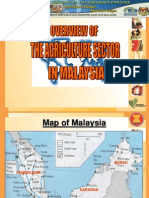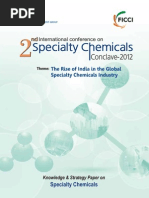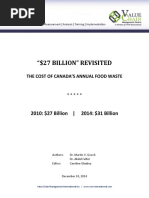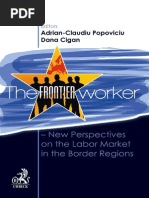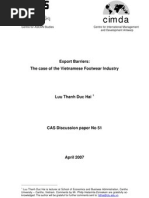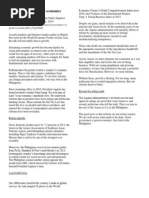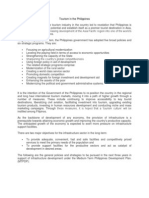Project Report
Project Report
Uploaded by
Adnan MadiwaleCopyright:
Available Formats
Project Report
Project Report
Uploaded by
Adnan MadiwaleCopyright
Available Formats
Share this document
Did you find this document useful?
Is this content inappropriate?
Copyright:
Available Formats
Project Report
Project Report
Uploaded by
Adnan MadiwaleCopyright:
Available Formats
GOLD SEAL- SAARGUMMI India Pvt.
Ltd
Table of Contents:
Part A 1. Industry Profile..... .....1-6 2. Company Profile......... 2.1. Background of the Company..7-8 2.2. Vision, Mission and Quality Policy9 2.3. Nature of Business........9 2.4. Products/Services ......9 2.5. Area of Operation......9 2.6. Ownership Pattern.......9 2.7. Competitors Information......9-10 2.8. Infrastructure Facilities......9-10 3. Mckinseys 7S framework......11-12 4. Management Profile...........................................................................13 5. SWOT Analysis............ 14 6. Analysis of Financial Statements.........15-21
Page | 1
GOLD SEAL- SAARGUMMI India Pvt. Ltd
7. Learning Experience.........22 Part B General Introduction. ..........23 1. Statement of Problem24 2. Objectives of Study.....25 3. Scope of Study.......26 4. Methodology .......26 5. Limitation of Study......27 Analysis, interpretation of results findings 1. Interpretation of the Data.28-55 2. Findings .......... 56 3. Conclusions ..........57-58 4. Recommendations .....59 Bibliography .............60
Page | 2
GOLD SEAL- SAARGUMMI India Pvt. Ltd
PART- A
Page | 3
GOLD SEAL- SAARGUMMI India Pvt. Ltd
I.
INDUSTRY PROFILE :
Indian Manufacturing Industry Profile:
The Indian economy is firmly on the path of steady growth. Even during the last decade when other countries were in the grip of a massive slowdown, India continued to enjoy a comfortable economic position. This recent spurt in growth is propelled by radical reforms such as the removal of restrictions on foreign investment and industrial de-licensing. Tailoring the EXIM policy to promote exports and aligning the import duties to meet WTO commitments further contributed to this development. This trend is expected to continue over the next five years, driven by a favourable business policy environment in terms of tax cuts, broadening tax base, and reduced interest rates. The liberalization of the economy has opened new windows of opportunity for manufacturing sector. Increasingly the success of manufacturing industries is dependent on innovations, research and development. It is critical not only to remain competitive but also, significant advantages can be gained by developing and commercializing new technologies. With a size of US $ 22 billion, the engineering sector exports stood at US $ 6.6 billion in 2001-02 and imports at US $ 4.9 billion the same year. Indian engineering manufacturing sector employs over 4 million skilled and semi-skilled workers. The engineering manufacturing sector comprises of heavy engineering (70%) and light engineering (30%). Indias growing integration with the global economy and the governments recognition that infrastructure needs to be overhauled are likely to ensure that the trend rate of growth increases in the next decade.
Page | 4
GOLD SEAL- SAARGUMMI India Pvt. Ltd
Industrial growth
The manufacturing sector grew by 8.9% in 2004-05, comfortably outperforming the sectors long term average growth rate of 7%. The sector has remained one of the engines of economic growth since the start of 2005-06. Industrial growth averaged 7.1% per annum in the 1980s. It accelerated slightly to 7.6% per year in the first five years following the beginning of the economic policy reform process in 1991. In the second half of the 1990s industrial growth trended lower at around 5% per annum. However, since 2002-03 industrial growth has accelerated markedly on the back of recent strong GDP growth. Rising disposable incomes, easy access to finance and the changing attitudes of Indias rapidly rising middle class (with a traditional focus on savings) have resulted in a consumer lending boom. Industrial growth rose above 8% in 2004-05, with consumer durables and non -durables showing exceptionally strong growth. Capitalgoods production has been growing at double-digit rates since 2002-03, suggesting increased investment in the industrial sector and the economy as a whole.
Macro-Level Bottlenecks for growth
Critical issues for growth are Historical focus on small scale unorganized manufacturing units, Poor infrastructure and High cost of power. The other important reasons for the Indian manufacturing being not competitive enough include: 1. Poor quality of transport infrastructure across all sectors including port facilities (where productivity is among the lowest in the world), surface roads, railways, airports and waterways. 2. High cost of power. Industrial power continues to be among the most expensive in the world. It is about 50 per cent more expensive than in China. 3. High cost of capital: It continues to be 10-12 % against international average of 6-8%.
Page | 5
GOLD SEAL- SAARGUMMI India Pvt. Ltd
Manufacturing Technology Status
Technology development is critical to a country's efforts in improving productivity, efficiency and competitiveness of its industrial sector. Factor cost advantages are being replaced by technology - related factors such as zero-defect product quality and international certification of firms' quality assurance systems (e.g., ISO 9000) in determining international competitiveness. Central to maintaining competitiveness is the ability of producers to respond quickly and effectively to the changing demands of the international market. Technological capabilities can be best described in terms of three levels: the basic level involves the ability to operate and maintain a new production plant based on imported technology, the intermediate level consists of the ability to duplicate and adapt the design for an imported plant and technique elsewhere in the country or abroad, while an advanced level involves a capability to undertake new designs and to develop new production systems and components. Most Indian manufacturing firms appear to be stuck at the basic or intermediate level of technological capabilities. Though Indian manufacturing industry has mastered standard techniques it has remained dependent for highly expensive and complicated technologies.
Sector Technology
Food Processing Metal forming and forging Steel Machine Tools Pharmaceuticals Chemicals Electrical and Electronics Automotive Auto Components IT Telecommunication Petrochemicals Light Engineering
Capability Level
Basic Basic Intermediate Basic Intermediate Basic Basic Intermediate Advanced Advanced Advanced Intermediate Basic
Page | 6
GOLD SEAL- SAARGUMMI India Pvt. Ltd
Profile of key manufacturing sub-sector AUTO COMPONENTS
Key Facts Size: USD 6.7 Billion Exports: USD 1 Billion Growth: 25% per annum
Indian auto component industry has grown from USD 3.9 Billion to USD 6.7 Billion in 3 years (2003-04) as India is becoming a preferred destination for sourcing by Original Equipment Manufacturers and growth of domestic auto industry. The attractiveness of Indian industry can be explained by the fact that presently around 12 global auto giants have set up international purchasing offices in India and 150 more are expected by 2010. India offers OEMs (original equipment manufacturers) a great cost -quality proposition, thus making it a preferred destination for outsourcing. Indian manufacturers enjoy the advantages of cheaper raw materials and availability of educated, qualified and skilled labour as well as engineers and designers at much lower costs. Technological advancements made by some of these domestic players have allowed them to become integrated partners rather than mere outsourcing partners. Indian automobiles and components are gaining increasing acceptance in world markets due to their cost -competitiveness. Auto components exports have shot up from $578 million in 2001-02 to $1000 million in 2003-04. The industry expects the growth to continue as domestic manufacturers acquire greater technological skills.
Technology Status
Indian companies are no longer restricting themselves to component manufacturing. They are also focusing on using their expertise in CAD/CAM and in designing and engineering capabilities by entering into designing and development of components for new product. Indias automotive component industry manufactures the entire range of parts required for vehicle manufacture. To meet international quality requirements and for tapping the global markets, the Indian auto ancillary units have entered into joint ventures with MNCs.
Page | 7
GOLD SEAL- SAARGUMMI India Pvt. Ltd
II.
COMPANY PROFILE:
Gold Seal- SAARGUMMI India Pvt. Ltd. is a JV between 2 technology leaders - Gold Seal of India and SAARGUMMI of Germany.
Name of the company: GOLD SEAL SAARGUMMI INDIA (P) LTD.
CEO Directors
: :
Cyrus H. Aga Pilloo Aga Khursheed Aga Urvaksh Aga
Registered Office
GOLD SEAL HOUSE, OPP. NAHUR STATION (W), VILLAGE ROAD, BHANDUP, MUMBAI-400 078
E-mail Type of Industry Location of plants Built up area
: : : :
sales@goldseal.in Private Ltd 1) Daman, 2) Mumbai Mumbai: 5075sq.mtrs, Daman: 6430sq.mtrs.
Year of establishment Turnover Total employees Bankers Auditors
: : : : :
Dec 1997 Rs. 10 - 25 Crore Mumbai: 201, Daman: 237 Bank of India Delloite Touch Tohmatsu Limited Page | 8
GOLD SEAL- SAARGUMMI India Pvt. Ltd
(DTTL)
A. BACKGROUND AND INCEPTION OF GOLD SEAL SAARGUMMI INDIA Pvt. LTD.
Gold Seal started operations in 1958 and manufactured the first Indian Door Seal and Window Channel, fitted as OEM on the first Indian car. Gold Seal has maintained its Quality & Brand Leadership with leading Indian OEMs and supplies its ever expanding range of products of EPDM (Ethylene Propylene Diene Monomer) rubber, PVC (Poly Vinyl Chloride), Nit rile, and TPE (Thermoplastic Elastomer/Rubbers) extruded sealing profiles to more than 25 OEM locations all over India from its 2 plants in Mumbai and Daman. Gold Seals continuous focus on quality and innovation ensures OEM customer satisfaction & the ever growing export markets in Africa, Australia, European Union, Middle East, South East Asia, and the United Kingdom are testimony to the same. SAARGUMMI is the innovation leader for body sealing systems with 14 manufacturing locations worldwide. SAARGUMMI is the 5th largest sealing system supplier worldwide and the 3rd largest in Europe. Recently SAARGUMMI won the prestigious Factory of the year/ Global excellence in operations award for its outstanding innovations. SAARGUMMI has competence within the complete value added chain including material development, product design and manufacturing of complex sealing systems. Gold Seal- SAARGUMMI India Pvt. Ltd. is JV between 2 technology leaders - Gold Seal of India and SAARGUMMI of Germany. GSSG has TS16949 / ISO14001 certified plant in Daman for extrusion of complex and Innovative EPDM Weather strips & a plant in Mumbai for finishing operation. GSSG works closely with Indian OEMs from design to final Production.
Page | 9
GOLD SEAL- SAARGUMMI India Pvt. Ltd
B. NATURE OF BUSINESS CARRIED
The Organization is the Largest Manufacturers, O.E.M. Suppliers & Exporters of Automobile Body Trimmings.
C. i) OBJECTIVE
The objective of Gold Seal Engineering is to consistently achieve customer requirements with minimum variability at the lowest cost possible by harnessing the potential of all employees in the organization.
ii) QUALITY POLICY
Gold Seal Management practices and employee work activities will, without expectation promote on time delivery of products & services which are consistently in conformance with customer requirements to achieve high levels of customers satisfaction. The company is committed to a policy of right first time and continual improvements in all activities, especially in the quality of product, management systems and services throughout its supply chain. Cyrus H. Aga- C.E.O.
iii) BUSINESS PHILOSOPHY
Excellence through Quality, Honesty & Transparency in all RELATIONSHIPS.
Page | 10
GOLD SEAL- SAARGUMMI India Pvt. Ltd
D. PRODUCTS/ SERVICES PROFILE
The company serves the automotive industry by providing: Automotive Mouldings: Development and production according to customer specifications Passenger cars Commercial vehicles Motorcycles Mouldings are available for the following areas of application: Motor Chassis Body Exhaust system Fuel tank
Page | 11
GOLD SEAL- SAARGUMMI India Pvt. Ltd
Products: Rubber ProductsGold Seal offers a complete range of Rubber Products. Its Rubber Products are widely used for various industrial applications. It makes use of the best raw material for manufacturing these products. It provides three kinds of Rubber Products namely, Industrial Rubber Beadings, Windshield Rubbers and Rubber Extruded Profiles.
All these are explained in detail below: 1. Industrial Rubber Beadings:
Gold Seal is the leading manufacturers and suppliers of qualitative container seals that are widely used in the automobile industry. These container seals are offered in various specifications as per the requirement of the clients.
2. Windshield Rubbers
The robust windshield rubbers are made of single component Solid rubber. The EPDM compound is formulated for long lasting resistance to weathering forces like Ozone, salt spray etc. The range extends from small size automobiles to large and heavy trucks as well, applicable on Indian as well as foreign range of vehicles. Page | 12
GOLD SEAL- SAARGUMMI India Pvt. Ltd
3. Rubber Extruded Profiles
The solid or sponge rubber profiles of varying hardness, find their application as Windshield Finishers, Backlight Finishers, Sunroof Seals, Rocker Panel Seals etc. They are also supplied with heat bond laminated 3M self adhesive tapes, as per customer requirements. This allows for easy application on the body, for sealing any gaps, between the panels of the vehicle.
Mechanical seals
Gold Seal offers a wide range of Mechanical Seals. Its range of mechanical seals is used variedly according to its types. It makes use of the best raw material for manufacturing these products. Gold Seal offers its clients with many types of Seals that are described in detail below: Car Seals and Weather-strips: Gold Seal is one of the leading manufacturers and suppliers of high quality EPDM Rubber extruded a wide range of car sealing systems. Its range includes: Sun roof seal Rocker seal Sun roof seal Windshield finisher Door-to-door seal Rear window finisher Page | 13
GOLD SEAL- SAARGUMMI India Pvt. Ltd
Trunk seal Glass run seal Flocked Channels Primary deal seal
1. Conventional Seals & Window Channels
Gold Seals Pioneering product, still finds application on vehicles today. These channels made with Natural Rubber and Cloth flock are used in Door Channels and Window Channels, of the Classic Cars and trucks. They may be supplied in cut-lengths or rolls, as per the customers requirement.
2. Heavy Equipment Rubber Seal
Gold Seal is also engaged in manufacturing an array of Heavy Equipment Sealers Profiles that is used in the automobile industry. It uses premium grades of raw material in manufacturing these seals. It always makes sure that the seals manufactured meet the requirements of the clients in the efficient manner.
3. Sponge Profile Door Seals The Bi-component profiles are co-extrusions of solid and sponge rubber. They may be designed with or without flexible metal reinforcement, or with single or Page | 14
GOLD SEAL- SAARGUMMI India Pvt. Ltd
double bulbs, as per the application requirements. Mainly used as primary and secondary door seals, B-pillar seals, boot or bonnet seals or roof line seals. Also supplied with specialised slip - coatings to reduce noise and vibrations.
Page | 15
GOLD SEAL- SAARGUMMI India Pvt. Ltd
4. Bonnet & Dicky Seals
Gold seal manufactures a wide range of boot and bonnet seals that is widely used in the automobile industry. Its range of boot and bonnet seals is widely used in the renowned brands such as Opel, Fiat, Ford and many others. The boot seals are used in Opel, Ford Icon and Fiat-124 models. These can also be customized as per the specifications provided by our clients. Our range of bonnet seals is used in the models such as Opel Astra, Opel Corsa and Suzuki 800.
5. Building Construction Rubber Seals
These seals are specially designed and developed by experts in order to meet the specific requirement of the clients. It also can develop parts according to customers samples or drawing etc.
Page | 16
GOLD SEAL- SAARGUMMI India Pvt. Ltd
E. Area of Operation : Global F. Ownership pattern: 50:50 (Partnership)
E. Infrastructural facilities:
Gold Seals robust infrastructure set-up enables it to fabricate the entire production orders well within time. Its manufacturing unit is spread across a sprawling area and equipped with all the requisite facilities that enable the smooth production process of its range with a minimum cost. Gold Seal is having the latest methods to check the quality of the goods at every level of production stage. The in-house product development unit is constantly involved in conceptualizing innovative ideas for its range of channels, seals and other allied products. Gold Seal has two manufacturing units located in: Daman (GSSG Plant Area - 3130 sq.mtrs) Mumbai (GSSG Plant Area - 700 sq.mtrs)
Some of the equipment installed in the Daman Plant includes: Extrusion Dual Extrusion Lines Microwave and Hot Air Continuous Vulcanization Systems Automatic Cutting Machines Moulding Injection Moulding Machines Transfer Moulding Machines Compression Moulding Machines Finishing Cutting Presses
Page | 17
GOLD SEAL- SAARGUMMI India Pvt. Ltd
Quality Assurances Rheometer Viscometer Universal Tensile Tester Profile Projector Flock Abrasion Tester The equipment installed in the Mumbai plant includes: Injection Moulding Machines Heat Bond Laminators Cutting & Finishing machinery
Highlights of Gold Seals infrastructural facilities: Imported Dual Extrusion Lines with continuous vulcanization with microwave technology. Fully Fledged Laboratory and QUALITY Assurance Equipment. In-house Capability from Design to Manufacture of Products & Equipment's. Established backward integration for sub components. Versatile Machinery to make Custom made profiles at Competitive rates.
Page | 18
GOLD SEAL- SAARGUMMI India Pvt. Ltd
H) Awards and Achievements:
Gold Seal has won numerous Export Awards over the years from All India Rubber Industries Assoc. (AIRIA), Chemical and Allied Products Export Promotion Council (CAPEXIL) & Engineering Export Promotion Council (EEPC). Gold Seal also got an Award from President of India in Silver Jubilee year. Saargummi won the prestigious Factory of the Year/ Global excellence in Operations award for its outstanding innovations.
I) Customer Information:
Gold Seal & SAARGUMMI Worldwide Customers: TATA Motors Volkswagen (VW) Swaraj Mazda Visteon Suzuki SMART Skoda Auto SERT SAAB Porsche OPEL Mercedes Benz Man Force Trucks Pvt. Ltd Mahindra & Mahindra Audi Page | 19
GOLD SEAL- SAARGUMMI India Pvt. Ltd
HONDA General Motors (GM) FORD FORCE EICHER FIAT DAIMLER BMW (Bavarian Motor Works) BAJAJ AOGL
Page | 20
GOLD SEAL- SAARGUMMI India Pvt. Ltd
J) WORK FLOW MODEL: RAMCO ERP SYTEMS. (IN SYSTEM PROCESS)
MATERIAL RESOURCE PLANNING (MRP)
SALES ORDER FORECAST SUPPLIE R
PURCHASE REQUEST PURCHASE ORDER
INWARDS GOODS RECEIPT (IGR)
RAW MATERIAL WAREHOUSE (RMWH)
STOCK TO PRWH (STOCK TRANSFER TO PRODUCTION WAREHOUSE)
R.M. CONVERSI ON INTO S.F. S.F. INTO F.G.
PRODUCTION PLAN (GENERATED BY MRP) QUICK WORK ORDER (QWO) RM TO SF SF (SEMIFINISHED) FG (FINISHED GOODS) FG BOOKED TO FGWH (FINISHED GOOD WAREHOUSE) PACKSLIP/ INVOICE
DISPATCH TO CUSTOMERS
Page | 21
GOLD SEAL- SAARGUMMI India Pvt. Ltd
III.
Mckinseys 7s model:
Style:
Gold Seal follows Participative (Democratic) type of leadership. In Gold Seal the style followed is Participative (Democratic) type of leadership. In this type of style the leader includes one or more employees in the decision making process (Determining what to do and how to do it). However the leader maintains the final decision making authority. Gold Seal uses this type of leadership style because the leader possesses a part of the information, and his employees have other parts. Note that a leader is not expected to know everything; this is why he employs knowledgeable and skilful employees. This style used is of mutual benefit as it allows the gold seal employees to become part of the team and allows the leader to make better decisions.
Page | 22
GOLD SEAL- SAARGUMMI India Pvt. Ltd
Strategy:
Adopting good manufacturing practices in order to obtain export approvals from MNC OEMs, and, projecting better image while competing. Keeping Quality as the main criterion and meeting the global quality standards, in order to get the contracts and maintain their current customers by providing standard products.
Shared Values:
The company is committed to a policy of continual improvement in all activities. Mutual trust and prosperity to determine healthy vender relationship. High concern for quality, safety and work environment in managing operations. Ethical, promptness, hard work, social responsibility. Customer satisfaction is of cordial value of Gold Seal.
System:
Is equipped with all modern equipments. TS16949 / ISO14001 certified for quality assurance.
Staff:
It selects those position or specialised people who have ability or skills to perform their duties as per the requirements of the company such as expert supervisor in their respective works, departmental heads such as Finance, HR, Quality control and Marketing & Sales etc. The company has hired eligible people, trains them well and assigned them the right jobs. Selection, training, reward and recognition, motivation and assignment of works to appropriate people are all key issues.
Page | 23
GOLD SEAL- SAARGUMMI India Pvt. Ltd
Page | 24
GOLD SEAL- SAARGUMMI India Pvt. Ltd
Skills:
Gold Seal is mainly recommended for the quality assurance purpose. The company is adopting new technology to develop the productivity and to have an effective control over the activities of the company. It ensures of securing Quality, Timing and Cost. The company has hired eligible people, trains them well and assigned them the right jobs so the current employees/team members have the ability to do the job very well.
Organization Structure:
CHIEF EXECUTIVE OFFICER DIRECTO RS
PRODUCTI ON Division PRODUCTI ON Units
QUALITY CONTRO L Division QUALITY CONTR OL Units
SALES Divisio n SALES Units
I.T Division I.T Units
FINANCE & ADMIN. Division FINANCE & ADMIN. Units AUDITO R
HR Division HR Units
SECURITY Departme nt
Page | 25
GOLD SEAL- SAARGUMMI India Pvt. Ltd
IV.
SWOT ANALYSIS:
The setting of the objective should be done after the SWOT analysis has been performed. This would allow achievable goals or objectives to be set for the organization. Strengths: characteristics of the business that give it an advantage over others. Weaknesses: are characteristics that place the team at a disadvantage relative to others. Opportunities: elements that the organization could exploit to its advantage. Threats: elements in the environment that could cause trouble for the business.
Strength:
Full Technical and Financial support from Joint Venture partners. Position in the international market. Day to day activities controlled by management. Good working conditions. Honesty, Transparency & True partnership with all Stakeholders. ISO/TS16949 Certified. The Company has a good reputation among its customers and suppliers. Reliable suppliers with superior quality assurance.
Weakness:
Fluctuating government policies. Inflation.
Page | 26
GOLD SEAL- SAARGUMMI India Pvt. Ltd
Opportunities:
Continuous pressure on global OEMs and Tier 1s to reduce cost and source from low cost countries. The growing need to outsource. Leverage on product engineering expertise to improve the worthiness and exports of auto component. Global market opportunity. Higher frequency of introducing of newer models by automakers. Cheap labour.
Threats:
Exchange-rate variations. Developments of new technologies like fuel cell, hydrogen powered vehicles. Free Trade Agreements / Preferential Trade Agreements (FTAs). Tax structure especially the disparity in custom and excise duties on the raw material of auto components.
Page | 27
GOLD SEAL- SAARGUMMI India Pvt. Ltd
ANALYSIS OF FINANCIAL STATEMENTS:
RATIOS 1 Current asset ratio Current asset Current liabilities 2012 2011
18,20,70,638 20,74,05,393 0.878
14,48,71,902 16,42,38,331 0.88
Quick Assets Ratio Quick Assets Current liabilities 15,46,53,968 20,74,05,393 0.75 13,05,26,407 16,42,38,331 0.79
Cash coverage ratio Earnings Before Interest and Taxes + Non-Cash Expenses / Interest Expense
65,19,953 90,80,595 1,26,78,240 1.23
1,38,24,209 75,33,577 86,88,032 2.46
Fixed Assets Turnover Ratio Net Sales Net Fixed Assets
63,86,00,894 7,87,54,933 8.11
44,38,63,385 7,05,79,725 6.29
Capital Turnover Ratio Net Sales Capital Employed 63,86,00,894 6,14,77,949 10 44,38,63,385 5,39,42,290 8
Return on Equity (ROE) Profit after interest, Tax & Pref. Dividend Equity Shareholder's Funds X 100 Debt-Equity Ratio Total liabilities Equity or Shareholders' Funds
38,34,953 5,40,47,024 7
84,54,209 5,39,42,289 15.67
22,48,42,241 5,40,47,024 4.16
RATIOS:
Page | 28
GOLD SEAL- SAARGUMMI India Pvt. Ltd
Ratio analysis:
1. Current ratio
The current ratio for the year 2011 is indicating 0.88 and for the year 2012 it is 0.87. As the ratio is under 1 the company will be unable to pay off its obligations if they came due at that point. While this shows the company is not in good financial health, it does not mean that it will go bankrupt.
2. Quick assets ratio
Quick ratio is 0.75 for 2012 and for 2011 it is 0.79, as calculated. The short term liquidity of the company is reduced against the previous year liquidity i.e. of 2011; the company is not quite capable of meeting its short term obligations with its most liquid assets. However, the company is stable in its financial standing.
3. Cash coverage ratio
The cash coverage ratio indicates a stable standing of the company, as the company is capable of paying its interest expenses with the available amount of cash they possess. The ratio calculated is, for 2012- 1.23:1 and for 2011- 2.46:1. Evidently, there has been reduction, comparatively.
4. Fixed Assets turnover ratio
The company has posted a higher fixed asset turnover ratio, which means, the company has been more effective in using the investments in fixed assets to generate revenues.
5. Capital turnover ratio
The capital turnover ratio is high, which shows the companies effectiveness in using its invested capital and generating good revenues from capital employed.
Page | 29
GOLD SEAL- SAARGUMMI India Pvt. Ltd
6. Return on equity
The companys Return on net worth is 7% as a percentage of shareholders equity, the company possess a good profitability by using the money shareholders have invested but evidently the returns to equity have been reduced to a high extent in 2012, compared to the ROE of 2011.
7. Debt-Equity ratio
The debt equity ratio, i.e. 4.16 in 2012, shows that the company has been aggressive in financing its growth by debt. As this company is in auto component manufacturing, they tend to have a debt/ equity ratio above 2.
Page | 30
GOLD SEAL- SAARGUMMI India Pvt. Ltd
Particulars A 1 EQUITY AND LIABILITIES Shareholders funds (a) Share Capital (b) Reserves and Surplus Non-current liabilities (a) Long Term borrowings (b) Deferred Tax liabilities (c) Long-Term provisions Current liabilities (a) Short-term borrowings (b) Trade payables (c) Other current Liabilities (d) Short-term provisions TOTAL B 1 ASSETS Non-current assets (a) Fixed Assets (i) Tangible assets (ii) Intangible assets (iii) Capital work-in-progress
As on 31 March 2012 Rs.
As on 31 March 2011 Rs.
31883580 22163444 54047024 6538737 10005923 892188 17436848 110148844 83318550 11656359 2282186 207405393 278889811
3,18,83,580 2,20,58,709 5,39,42,289
91,35,923 9,54,661 10090584 97405353 48266796 16907366 1658816 164238331 228271204
90086641 631175 715357 91433173 100000 5286000 5386000 27416670 112776875 3055527 38804205 17361 182070638 278889811
78113302
78113302
(b) Non-current Investments (c) Long term loans and advances 2 Current assets (a) Inventories (b) Trade receivables (c) Cash and cash equivalents (d) Short-term loans and advances (e) Other current assets TOTAL
5286000 5286000 14345495 102743075 2790692 24976249 16391 144871902 228271204
BALANCE SHEET as on 31March 2012 and 31MARCH 2011:
Page | 31
GOLD SEAL- SAARGUMMI India Pvt. Ltd
Profit and Loss A/C as on 31March 2012 and 31MARCH 2011: Particulars A CONTINUING OPERATIONS 1 Revenue from operations (gross) Less: Excise duty Revenue from operations (net) For the year ended 31 March 2012 Rs. 70,66,88,072 6,80,87,178 63,86,00,894 37,642 63,86,38,536 For the year ended 31 March 2011 Rs. 47,92,58,100 3,53,94,715 44,38,63,385 2,12,951 44,40,76,336
2 3 4
Other income Total revenue (1+2) Expenses a) cost of materials consumed b) changes in inventories of finished goods, work-in-progress and stock in trade c) employee benefits expense d) finance costs e) depreciation and amortisation expense f) other expenses TOTAL EXPENSES Profit / (Loss) before tax (3 -+ 4) Tax expenses: a) Current tax expense for current year b) Deferred tax
47,78,09,379 -66,39,179 4,31,48,074 1,26,78,240 90,80,595 9,60,41,474 63,21,18,583 65,19,953
30,67,95,394 30,89,062 2,92,04,029 86,88,032 75,33,577 7,49,42,033 43,02,52,127 1,38,24,209
5 6
18,15,000 8,70,000 26,85,000 38,34,953 1.2 2.65
51,00,000 2,70,000 53,70,000 84,54,209
7 8
Profit/ (Loss) for the year (5+-6) Earnings per share (of Rs.10/- each): Basic and diluted
Page | 32
GOLD SEAL- SAARGUMMI India Pvt. Ltd
V.
Learning Experience:
I was very fortunate to undergo project at GOLD SEAL Engineering Products Pvt. Ltd, Mumbai. It is Indias Pioneer & Leader in Rubber Weather-strips together with Global Leaders in Technology & Innovation. I could understand various dynamics of this, manufacturing sector during my industry study. This project has made me realize what additional competencies & skills I may have to develop to be a successful professional. I learned how communication is essential in corporate world. By and large it was a new and very helpful experience, of undergoing project at, GOLD SEAL Engineering Products Pvt. Ltd, as I could observe the way in which an organisation of its size actually functioned.
Page | 33
GOLD SEAL- SAARGUMMI India Pvt. Ltd
PART-B
Page | 34
GOLD SEAL- SAARGUMMI India Pvt. Ltd
STANDARD COST & VARIANCE ANALYSIS
Page | 35
GOLD SEAL- SAARGUMMI India Pvt. Ltd
A) General Introduction
Statement of the problem:
In India the setup of multinational companies has given rise to cut throat competition and strive to survive and grow continuously from its present state and becoming competitive in nature. Decrease in costs in turns increases profits, so the manufacturer has to keep a close watch and control over the costs. A manufacturer incurs cost in conversion of raw materials into finished goods and selling the same to the consumer. It is essential to keep a careful watch on such costs incurred and check upon the variances in cost which has an effect on the profits. Thus, cost analysis will make us understand the cost variances and also help us to find out measures to optimise them.
Objective of the Study:
The objective of the study is: To understand the Standard cost and variance analysis procedures followed in Gold Seal, comparing the standard costs with actual costs to find out favourable or unfavourable variances and analysing those variances to understand what are the reasons for such variances. To achieve this purpose, I have chosen Gold Seal-Saargummi India Private Ltd, and studied Sales margin report, trial balance for the month of JANUARY 2013 and its financial statement.
Page | 36
GOLD SEAL- SAARGUMMI India Pvt. Ltd
Scope of the study:
The scope of study is confined to the information disclosed by each and every department head. The study is concerned to the Financial Department of Gold Seal Ltd. Mumbai unit. The attempt is made to understand Standard Cost and Variance analysis procedures implemented in Gold Seal Ltd. Regular assignments are assigned to understand the financial work process and gain necessary information on the respective topic. Access to resources helped me to acquire information to the best of my need. The study is confined only to Gold Seal-SAARGUMMI India Pvt. Ltd.
Methodology:
Data sources: Both Primary & Secondary sources have been used.
Primary data: Primary data are the datas collected for the first time and are not available in the secondary source. Face to face interactions with Concern persons of respective departments and through discussions with my external guide Mr. Irshad Bahadursha.
Secondary data: Secondary data are the datas that are developed for some purpose other than helping to solve problem at hand.
The secondary sources of data are: Through companys financial statements, Trial balances, Cost reports, Sales Margin Reports, Bill of materials. Visiting Companys official website, and ERP systems i.e. Ramco systems of the company. By referring journals & PPTs prepared by the company personnel.
Page | 37
GOLD SEAL- SAARGUMMI India Pvt. Ltd
Limitations:
The study is concluded based on the information provided by my external guide, the facts and figures claimed in the companys record. Much interaction with company personnel was limited due to their busy schedules. The organization study is based in the discussions with the company personnels This report is prepared for academic purpose.
Page | 38
GOLD SEAL- SAARGUMMI India Pvt. Ltd
THEORETICAL ASPECTS OF STANDARD COST AND VARIANCE ANALYSIS
Introduction to Cost Accounting
COST ACCOUNTING: MEANING Cost accounting is regarded as the process of collecting, analyzing, summarizing and evaluating various alternative courses of action involving costs and advising the management on the most appropriate course of action based on the cost efficiency and capability of the management.
COST SHEET: MEANING Cost sheet is a statement, which shows various components of total cost of a product. It classifies and analyses the components of cost of a product. Previous periods data is given in the cost sheet for comparative study. It is a statement which shows per unit cost in addition to Total Cost. Selling price is ascertained with the help of cost sheet. The detail of total cost presented in the form of a statement is termed as Cost sheet. Cost sheet is prepared on the basis of: 1. Historical Cost 2. Estimated Cost
1. Historical Cost: Meaning Historical Cost sheet is prepared on the basis of actual cost incurred. A statement of cost prepared after incurring the actual cost is called Historical Cost Sheet.
2. Estimated Cost: Meaning Estimated cost sheet is prepared on the basis of estimated cost. The statement prepared before the commencement of production is called estimated cost sheet. Such cost sheet is useful in quoting the tender price of a job or a contract.
Page | 39
GOLD SEAL- SAARGUMMI India Pvt. Ltd
Page | 40
GOLD SEAL- SAARGUMMI India Pvt. Ltd
Importance of Cost Sheet: The importance of cost sheet is as follows: 1. Cost ascertainment The main objective of the cost sheet is to ascertain the cost of a product. Cost sheet helps in ascertainment of cost for the purpose of determining cost after they are incurred. It also helps to ascertain the actual cost or estimated cost of a Job. 2. Fixation of selling price To fix the selling price of a product or service, it is essential to prepare the cost sheet. It helps in fixing selling price of a product or service by providing detailed information of the cost. 3. Help in cost control For controlling the cost of a product it is necessary for every manufacturing unit to prepare a cost sheet. Estimated cost sheet helps in the control of material cost, labour cost and overheads cost at every point of production. 4. Facilitates managerial decisions It helps in taking important decisions by the management such as: whether to produce or buy a component, what prices of goods are to be quoted in the tender, whether to retain or replace an existing machine etc.
Sales If the profit margin is added to the total cost, sales are arrived at. Excess of sales over total cost is termed as profit. When total cost exceeds sales it is termed as Loss. Sales = Total Cost + Profit
Page | 41
GOLD SEAL- SAARGUMMI India Pvt. Ltd
Elements of cost:
Material (Material is a very important part of business) Direct material Labour Direct labour Overhead (Variable/Fixed) Indirect material Indirect labour Maintenance & Repair Supplies Utilities Other Variable Expenses Salaries Occupancy (Rent) Depreciation Other Fixed Expenses (In some companies, machine cost is segregated from overhead and reported as a separate element) They are grouped further based on their functions as:
Production or works overheads Administration overheads Selling overheads Distribution overheads
Page | 42
GOLD SEAL- SAARGUMMI India Pvt. Ltd
Classification of costs
Classification of cost means, the grouping of costs according to their common characteristics. The important ways of classification of costs are:
By nature or element: materials, labour, expenses. By functions: production, selling, distribution, administration, R&D. By traceability: direct and indirect. By variability: fixed, variable, and semi-variable. By controllability: controllable, uncontrollable. By normality: normal, abnormal. By Decision making Costs. Time of Occupation.
Page | 43
GOLD SEAL- SAARGUMMI India Pvt. Ltd
COST ACCOUNTING APPROACHES
Standardized or standard cost accounting Lean accounting Activity-based costing Resource consumption accounting Throughput accounting Marginal costing/cost-volume-profit analysis
STANDARDIZED OR STANDARD COST ACCOUNTING:
Standard costing is an important subtopic of cost accounting. Standard costs are usually associated with a manufacturing company's costs of direct material, direct labour, and manufacturing overhead.
Rather than assigning the actual costs of direct material, direct labour, and manufacturing overhead to a product, many manufacturers assign the expected or standard cost. This means that a manufacturer's inventories and cost of goods sold will begin with amounts reflecting the standard costs, not the actual costs, of a product. Manufacturers, of course, still have to pay the actual costs. As a result there are almost always differences between the actual costs and the standard costs, and those differences are known as variances.
REASONS FOR USING A STANDARD COSTING SYSTEM: Cost Control. Smooth out short-term fluctuations in direct costs. Costing systems that use budgeted data are economical.
Page | 44
GOLD SEAL- SAARGUMMI India Pvt. Ltd
VARIANCE ANALYSIS
In accounting, a variance is defined as the difference between the expected amount and the actual amount of costs or revenues. Variance analysis uses this standard or expected amount versus the actual amount to judge performance. The analysis includes an explanation of the difference between actual and expected figures as well as an evaluation as to why the variance may have occurred. The purpose of this detailed information is to assist managers in determining what may have gone right or wrong and to help in future decision-making. Variance analysis helps the management to understand the present costs and then control future costs.
FORMS OF VARIANCES
Positive/ Favourable Variance: (F) A variance can be put into the favourable category when the results are better than expected. This means that revenues were more than the expected amount or costs were below the budgeted amount. In accounting practice, a favourable variance is shown by noting a letter F in parenthesis on the reports. A favourable variance might earn a bonus for a manger, or perhaps a move up the corporate ladder.
Negative/ Unfavourable Variance: ( A / U) In contrast, the variance can be judged as unfavourable if the results are worse than expected. If the revenues were below expectations or the costs were higher than standard, the variance would be termed unfavourable or adverse. This would be denoted on the reports with the letter A or U, usually in parenthesis. Consistently creating an unfavourable variance might result in a manger being reprimanded or losing their job. However, the analysis is typically used to help mangers prevent a negative situation from recurring by providing information about what went wrong.
The standard cost of a finished product is the sum of the standard costs of the inputs:
Direct material Direct labour Page | 45
GOLD SEAL- SAARGUMMI India Pvt. Ltd
Manufacturing overhead Variable manufacturing overhead Fixed manufacturing overhead
Page | 46
GOLD SEAL- SAARGUMMI India Pvt. Ltd
STANDARD COST AND VARIANCE ANALYSIS PROCEDURE IN GOLD SEAL LTD.:
Sales margin report is generated for the companys ERP systems, i.e. Ramco systems.
The sales margin report consists of the quantity of items will be manufactured and sold during the particular month and the total value, total costs and profit of all the items.
The total cost is manually bifurcated into material cost and process cost. The material cost of each item is extracted by the help item code from Ramco systems one by one or using bill of materials prepared by finance personnel for convenience.
The scraps are separated from the total material costs according to the scrap provision made by the company.
Allocation of estimated expenses to each component of manufacturing expense are prepared considering the full capacity (70%), the estimated expenses are than calculated for the actual utilised capacity(53%) for the purpose of variance analysis.
Using the trial balance the actual costs incurred are extracted.
A cost sheet is prepared comprising of standard costs and actual costs, than variance percentage & amount is found, using this cost sheet.
Analysis and interpretation of the results is carried out, to understand the reasons for the variances and finding more efficient methods to controlling future costs.
Page | 47
GOLD SEAL- SAARGUMMI India Pvt. Ltd
STANDARD COSTS AND VARIANCE ANALYSIS FOR THE MONTH OF JANUARY 2013. Costing Variance (%) Comments Cost Analysis P&L (Standard January 2013 (Actual Costs) Costs)
SALES Less: Sales Returned Price diff Sale of scraps NET REVENUE DIRECT MATERIAL SCRAP 5,94,00,935 71,904 10,67,469 4,14,681.98 5,93,29,031 3,64,88,117 52,88,493 70.42% DIRECT LABOUR POWER STORES AND SPARES LEASE RENT INDIRECT LABOUR REPAIRS INSURANCE DEPRECIATION 22,04,292 12,81,962 3,83,534 17,09,050 14,25,352 1,42,044 1,41,654 11,70,000 5,87,71,263 3,64,61,035 46,90,504 70.02% 24,28,831 16,33,564 5,92,661 13,49299 20,43,057 2,49,686 70,152 10,37,873 (1,32,127) 2,24,539 10.2% 5,57,768 -27,082 -5,97,989 0.94% -0.07% 11.31% E-rate Variations is Rs.49,208 Excess scraps 5,90,66,596 2,95,333 -3,34,339 2,23,429 -0.56% 311% Supplementary Bills VW YOY 5% NOT REDUCED FROM 1 TO 20-1-13
10%
-11%
PLANT O/H TOTAL COST DIRECT PROFIT SELLING FINANCIAL DISTRIBUTION NET PROFIT
76,929 5,03,11,428 84.80% 90,17,603 12,09,588 1099930 3,18,430 63,89,655
1,10,825 5,06,67,488 86.21% 81,03,776
Depreciation is provided on the 5th line without full utilisation. Underutilisation of capacity 53% Professional charges & License fees Excluding Price differences
9,13,827
10.13%
81,03,776
Page | 48
GOLD SEAL- SAARGUMMI India Pvt. Ltd
Estimates of Expenses Calculated for the actual utilised capacity:
Allocated Expenses Direct labour Indirect labour Stores and spares Power Lease rent Repairs Depreciation Insurance Administrative O/H TOTAL Total Capacity 70% 26,66,973.0 22,43,375.0 6,50,770.0 17,93,732.0 14,81,595 2,74,167.0 9,86,776.0 77,030.0 1,21,691.0 1,02,96,109 Utilised Capacity 53% 24,28,831 20,43,057 5,92,661 16,33,564 13,49,299 2,49,686 10,37,873 70,152 1,10,825 93,76,739
Page | 49
GOLD SEAL- SAARGUMMI India Pvt. Ltd
CALCULATION OF VARIANCE:
Item code-S10031014 Item description- BOLERO BACK DOOR (M&M)
STANDARD [Production: 4470 units] Quantity(Kgs) Price per Kg Value/Cost (Rs) 4,635.39 118.31 5,48,412.99
ACTUAL [Production: 4470 units] 4,639.86 118.42 5,49,452.22
DIRECT MATERIAL PRICE VARIANCE:
Definition: The Direct Materials Price Variance is the difference between the actual and budgeted cost to acquire materials, multiplied by the total number of units purchased.
The material price variance is expressed as (AP SP)AQ
Where: (AP) = actual price per unit of material. (SP) = standard price per unit of direct material.
Page | 50
GOLD SEAL- SAARGUMMI India Pvt. Ltd
(AQ) = actual quantity of material purchased.
If actual price > standard price, then the variance is unfavorable. If actual price < standard price, then the variance is favorable
HERE, AP= 118.42 PER KG SP=118.31 PER KG AQ= 4639.86 KG
Therefore,
MPV= (118.42-118.31)*4639.86 MPV= 0.11*4639.86 MPV= 510.38 (A)
Page | 51
GOLD SEAL- SAARGUMMI India Pvt. Ltd
DIRECT MATERIAL QUANTITY VARIANCE:
Definition: The Direct Materials Quantity Variance is a measure of the difference between the actual quantity of materials used in production and the standard quantity allowed, multiplied by the standard price per unit of materials.
Direct Materials Quantity Variance is also known as direct materials efficiency variance and direct materials usage variance.
The material quantity variance is expressed as (AQ SQ)SP
Where: (AQ) = actual quantity of material used. (SQ) = standard quantity of material allowed. (SP) = standard price of material.
If actual quantity > standard quantity, then the variance is unfavorable. If actual quantity < standard quantity, then the variance is favorable.
HERE, AQ = 4639.86 SQ = 4635.39 SP = 118.31 Page | 52
GOLD SEAL- SAARGUMMI India Pvt. Ltd
Therefore,
MQV= (4639.86-4635.39)*118.31 MQV= 4.47*118.31 MQV=528.85 (A)
Page | 53
GOLD SEAL- SAARGUMMI India Pvt. Ltd
SALES:
Sales Returns
Description Sales Returns
Budget 2.95 Lacs
Actual 71.90 K
Variance 2.23 Lacs
INTERPRETATION: This chart indicates, the budgeted sales return is Rs.2.95 Lacs and the actual being Rs.71.9 K. Sales returns show Favourable variance.
There is a sales return of Rs.71.90K which is 0.12% of sales, as against cost support of 0.5%. As we notice in actually that the sales returns are down, showing efficiency, and the variance being 2.23 lacs.
Page | 54
GOLD SEAL- SAARGUMMI India Pvt. Ltd
The Sales amount in P & L A/c also includes re-imbursement of Rs.10 lacs, which are of earlier period and are not to be included for cost sheet analysis.
Page | 55
GOLD SEAL- SAARGUMMI India Pvt. Ltd
Material Cost:
Direct Material Cost:
Description Direct material cost
Budget 364.61 Lacs
Actual 364.88 Lacs
Variance -27.08 K
INTERPRETATION: As against the budget allowed of Rs.364.61 lacs and actual expenditure works out to Rs. 364.88 lacs, resulting in excess expenditure of Rs.27.08 K. Hence, there exists an Unfavourable variance.
There exists a slight increase in direct material actual cost i.e. by 0.10%, as compared to Standard cost, the reason being the Exchange Rate variations of Rs.49.20K.
Page | 56
GOLD SEAL- SAARGUMMI India Pvt. Ltd
SCRAPS:
Description Scraps
Budget 46.90 Lacs
Actual 52.88 Lacs
Variance 5.98 Lacs
S CRAPS
6,000,000 5,000,000 4,000,000 3,000,000 2,000,000 1,000,000 Budgeted Actual Variance Budgeted Actual Variance
INTERPRETATION:
The chart shows the actual scraps to be Rs.52.88 Lacs and budgeted is Rs.46.90 Lacs. The actual scraps are 14.5% of material cost and the provisioned scraps are 12.86% on net material cost. Thus, there is an excess in scraps of Rs. 5.98 lacs (11%). The scraps show an Un-favourable Variance.
Scraps are increased by Rs.5.98lacs; the scrap provision is made 5% on all the parts except VW (Volkswagen) which is 25%. The scrap needs to be brought down to 13% of
Page | 57
GOLD SEAL- SAARGUMMI India Pvt. Ltd
material cost or required to be revised, in standard cost sheets, to take care of 15%, or more realistic figures, as management finds ok with.
Page | 58
GOLD SEAL- SAARGUMMI India Pvt. Ltd
Material cost is 70.42%, when compared to standard material cost i.e. 70.02%, of sales value. Hence
the actual material cost is more by Rs. 6.25 lacs (Refer Cost-Variation Table)
Hence, Total Material cost is unfavourable; the company paid more than its standard cost for the direct materials it purchased and also there includes excess scraps.
Page | 59
GOLD SEAL- SAARGUMMI India Pvt. Ltd
Direct Labour Cost:
Description Direct Labour Cost
Budget 24.28 Lacs
Actual 22.04 Lacs
Variance 2.25 Lacs
INTERPRETATION:
The chart indicates the actual direct labour cost Rs. 22.04 lacs, against standard cost of Rs.
24.28 lacs, resulting in savings of Rs. 2.25 lacs, in respect of estimates.
The actual labour cost is lower by Rs. 2.25 lacs, though plant was underutilized its capacity, i.e. 53% OEE as against 70%. However, it could not establish whether this is quantity variation or price variation, due to limited information available.
Page | 60
GOLD SEAL- SAARGUMMI India Pvt. Ltd
Hence, direct labour rate is favourable, the Company paid less than its standard cost for the direct labour it used.
Page | 61
GOLD SEAL- SAARGUMMI India Pvt. Ltd
Manufacturing Overheads Spending including indirect labour :
Description Manufacturing overheads
Budget 70.87 Lacs
Actual 63.30 Lacs
Variance 7.57 Lacs
INTERPRETATION:
Against the budget allowed of Rs. 70.87 lacs and the actual overheads works out to be Rs. 63.30 lacs resulting in savings of Rs. 7.57 Lacs.
Hence, the manufacturing overhead spending has a favourable variance; the companys actual manufacturing overhead costs are less than the budgeted costs.
Page | 62
GOLD SEAL- SAARGUMMI India Pvt. Ltd
Page | 63
GOLD SEAL- SAARGUMMI India Pvt. Ltd
Indirect labour Stores and spares Power Lease rent Repairs Depreciation Insurance Administrative O/H
20,43,057 5,92,661 16,33,564 13,49,299 2,49,686 10,37,873 70,152 1,10,825
TOTAL OVERHEADS 70,87,117 Actual Manufacturing Overheads:
Indirect labour Stores and spares Power Lease rent Repairs Depreciation Insurance Administrative O/H TOTAL OVERHEADS
14,25,352 3,83,534 12,81,962 17,09,050 1,42,044 11,70,000 1,41,654 76,929 63,30,525
Estimated Manufacturing Overheads:
Page | 64
GOLD SEAL- SAARGUMMI India Pvt. Ltd
Total Cost:
Description Total Cost
Budget 506.67 Lacs
Actual 503.11
Variance 3.56 Lacs
INTERPRETATION: Against the budget allowed of Rs. 506.67 lacs and the actual expenditure cost works out to be Rs. 503.11 lacs resulting in the savings of Rs.3.56 Lacs i.e. the company is having 1% savings.
Hence, there is a favourable Total cost variance.
Page | 65
GOLD SEAL- SAARGUMMI India Pvt. Ltd
The cost variations for the period are as under:
Cost sheet comparison Sales Mat Cost Direct Labour Mfg Overheads Total Cost Gross Profit
Rs. In Lacs P&L A/C 593.29 417.77 22.04 63.31 503.11 90.18 Std % Costs % Variation % 100% 587.71 100% 5.58 0.95% 70.02 70.42% 411.52 % -6.25 -1.52% 3.72% 24.29 4.13% 2.25 9.24% 11% 70.87 12% 7.57 10.68% 85% 506.67 86% 3.56 0.70% 15% 81.04 14% -9.14 11.28%
The above chart shows that, the actual cost are more by 0.40% compare to standard cost sheets. This is on account of additional scraps 11%, exchange rates variation 0.07%.
Page | 66
GOLD SEAL- SAARGUMMI India Pvt. Ltd
FINDINGS:
Page | 67
GOLD SEAL- SAARGUMMI India Pvt. Ltd
CONCLUSIONS & RECOMMENDATIONS:
Page | 68
GOLD SEAL- SAARGUMMI India Pvt. Ltd
BIBLIOGRAPHY
WWW.GOOGLE.COM WWW.INVESTOPEDIA.COM WWW.WIKIPEDIA.COM WWW.ACCOUNTINGTOOLS.COM
COMPANYS MAGAZINES AND JOURNALS. PPTS COMPANYS OFFICIAL WEBSITE.
Page | 69
You might also like
- Domino's Pizza in AustraliaDocument31 pagesDomino's Pizza in Australiadrcalvin1100% (5)
- Operations Management in Automotive Industries: From Industrial Strategies to Production Resources Management, Through the Industrialization Process and Supply Chain to Pursue Value CreationFrom EverandOperations Management in Automotive Industries: From Industrial Strategies to Production Resources Management, Through the Industrialization Process and Supply Chain to Pursue Value CreationNo ratings yet
- (Financial Services) : "A Study On Financial AnalysisDocument70 pages(Financial Services) : "A Study On Financial AnalysisravichakaravarthiNo ratings yet
- Emily Hannum Globalization, Changing Demographics, and Educational Challenges in East Asia Research in Sociology of Education 2010Document320 pagesEmily Hannum Globalization, Changing Demographics, and Educational Challenges in East Asia Research in Sociology of Education 2010Dee Vignette100% (1)
- Marketing Project - Nokia PDFDocument13 pagesMarketing Project - Nokia PDFAbhishek Bansal50% (2)
- Emerging Market Strategy of ToyotaDocument12 pagesEmerging Market Strategy of ToyotaAbhimanyu Singh RathoreNo ratings yet
- Ji Ji Ji Ji Ji Ji JiDocument7 pagesJi Ji Ji Ji Ji Ji JiMonika WadhelNo ratings yet
- History and Development of Amul Indusries Pvt. Ltd.Document79 pagesHistory and Development of Amul Indusries Pvt. Ltd.asn8136No ratings yet
- Summer Project Report To CollegeDocument52 pagesSummer Project Report To CollegeVenkatraman NarayananNo ratings yet
- Imperial Auto SoroutDocument84 pagesImperial Auto SoroutGaurav100% (1)
- Automotive Components India PDFDocument30 pagesAutomotive Components India PDFyogipatilNo ratings yet
- Imperial Auto SoroutDocument83 pagesImperial Auto SoroutAnmol LimpaleNo ratings yet
- A Seminar Report On "Automobile Sector of India"Document33 pagesA Seminar Report On "Automobile Sector of India"Mohammad Anwar Ali100% (1)
- Automobile Industry IndiaDocument32 pagesAutomobile Industry IndiaNeha BhayaniNo ratings yet
- Amtek India LTDDocument8 pagesAmtek India LTDShochis NatrajanNo ratings yet
- Correlation: IP & Auto: Seminar ReportDocument19 pagesCorrelation: IP & Auto: Seminar ReportHimanshuGuptaNo ratings yet
- India Forging 2004Document9 pagesIndia Forging 2004Talib KhanNo ratings yet
- INTERNATIONAL MARKETING Auto ComponentDocument18 pagesINTERNATIONAL MARKETING Auto ComponentJas777100% (1)
- CreditDocument82 pagesCreditVitthal GoreNo ratings yet
- Fdi in Automobile Sector in IndiaDocument26 pagesFdi in Automobile Sector in Indiauditnarula09No ratings yet
- Customer Preference On Honda CarsDocument74 pagesCustomer Preference On Honda Carsselvi abraham100% (1)
- Sundaram Clayton Case StudyDocument25 pagesSundaram Clayton Case StudySathyanarayana A Engineering MechanicalNo ratings yet
- Auto Ancilary Macro ReportDocument88 pagesAuto Ancilary Macro ReportAdersh Ar Dahiya100% (1)
- Indian Forging Industry IframeDocument6 pagesIndian Forging Industry IframeshwetabajpaiNo ratings yet
- IIM-Auto Components 2Document27 pagesIIM-Auto Components 2singhania1989nehaNo ratings yet
- India Auto Supplychains-IyerDocument35 pagesIndia Auto Supplychains-IyerVenkateshwar Rao. RokandlaNo ratings yet
- Project Report-Porters Five Force Analysis of GDMDocument73 pagesProject Report-Porters Five Force Analysis of GDMajitbablu90No ratings yet
- Manufacturing: The India Value Proposition: October 2006Document19 pagesManufacturing: The India Value Proposition: October 2006shantnishantNo ratings yet
- Acma & KPMGDocument28 pagesAcma & KPMGShivanshuNo ratings yet
- Auto Component: Industry StructureDocument5 pagesAuto Component: Industry StructurechompoonootNo ratings yet
- Indian Auto OverviewDocument7 pagesIndian Auto OverviewsubgadNo ratings yet
- C7 - Force Automotive Breach of Code of ConductDocument12 pagesC7 - Force Automotive Breach of Code of ConductNutanNo ratings yet
- VTU MBA - Organizational Study (J P Foundries)Document45 pagesVTU MBA - Organizational Study (J P Foundries)Pranav Marathe100% (8)
- Diamond Model of Porter With Reference To Indian Automobile IndustryDocument7 pagesDiamond Model of Porter With Reference To Indian Automobile IndustrySupersamKhan0% (1)
- Market Adaptation of Volkswagen PoloDocument36 pagesMarket Adaptation of Volkswagen PoloRohit Sopori100% (1)
- Exide Industries Equity Research ReportDocument9 pagesExide Industries Equity Research ReportAadith RamanNo ratings yet
- Final ProjectDocument37 pagesFinal ProjectAnmolDhillonNo ratings yet
- Automobile Industry in India - Marketing ChallengesDocument21 pagesAutomobile Industry in India - Marketing ChallengesAnkit VermaNo ratings yet
- AutoDocument5 pagesAutoVed PrakashNo ratings yet
- Fulfiling Promise of India's Manufacturing SectorDocument10 pagesFulfiling Promise of India's Manufacturing SectorVishal BalaniNo ratings yet
- Suresh Final AmulDocument88 pagesSuresh Final AmulmayursailorNo ratings yet
- Get Fully Solved Assignment. Buy Online From Website: If Urgent Then Call Us On, 08273413412Document6 pagesGet Fully Solved Assignment. Buy Online From Website: If Urgent Then Call Us On, 08273413412Alex DoeNo ratings yet
- FM Capital ExpenditureDocument8 pagesFM Capital ExpenditureVimala Selvaraj VimalaNo ratings yet
- A Project Report On Study On Foundry Industry BelgaumDocument60 pagesA Project Report On Study On Foundry Industry BelgaumBabasab Patil (Karrisatte)100% (1)
- Part A IFB Full Project Final REPORTDocument37 pagesPart A IFB Full Project Final REPORTSrinivas Gowda100% (2)
- Sandaesh BFR 22Document44 pagesSandaesh BFR 22Nikhil hu Nikhil huNo ratings yet
- A Study On The Marketing Strategies of Maruti Suzuki Swift"Document40 pagesA Study On The Marketing Strategies of Maruti Suzuki Swift"Rohit KumarNo ratings yet
- Industry ProfileDocument10 pagesIndustry ProfileSathya BharathiNo ratings yet
- Mba-Project On V.S EnterprisesDocument53 pagesMba-Project On V.S EnterprisesTarun MalhotraNo ratings yet
- Indian MFG IndustryDocument3 pagesIndian MFG Industryharsh_2404No ratings yet
- KLJ Group - BBA Summer ReportDocument54 pagesKLJ Group - BBA Summer ReportHardik SNo ratings yet
- VANSHIKA Industry Overview - Automobile - DraftDocument18 pagesVANSHIKA Industry Overview - Automobile - DraftKinshuk AcharyaNo ratings yet
- A Study On Consumer Preference Towards Honda Cars in TambaramDocument74 pagesA Study On Consumer Preference Towards Honda Cars in TambaramTamil film zoneNo ratings yet
- 1.1 Objectives of The InternshipDocument14 pages1.1 Objectives of The InternshipangeNo ratings yet
- Construction Equipment IndustryDocument6 pagesConstruction Equipment IndustryJaison JosephNo ratings yet
- Mproject.mbaDocument31 pagesMproject.mbaPrachi JainNo ratings yet
- Project Final YearDocument79 pagesProject Final YearTamil film zoneNo ratings yet
- Cost Reduction Techniques FinalDocument75 pagesCost Reduction Techniques FinalJig HiraniNo ratings yet
- Policies to Support the Development of Indonesia’s Manufacturing Sector during 2020–2024: A Joint ADB–BAPPENAS ReportFrom EverandPolicies to Support the Development of Indonesia’s Manufacturing Sector during 2020–2024: A Joint ADB–BAPPENAS ReportNo ratings yet
- Leveraging on India: Best Practices Related to Manufacturing, Engineering, and ItFrom EverandLeveraging on India: Best Practices Related to Manufacturing, Engineering, and ItNo ratings yet
- A Study of the Supply Chain and Financial Parameters of a Small Manufacturing BusinessFrom EverandA Study of the Supply Chain and Financial Parameters of a Small Manufacturing BusinessNo ratings yet
- Innovate Indonesia: Unlocking Growth Through Technological TransformationFrom EverandInnovate Indonesia: Unlocking Growth Through Technological TransformationNo ratings yet
- A Study of the Supply Chain and Financial Parameters of a Small BusinessFrom EverandA Study of the Supply Chain and Financial Parameters of a Small BusinessNo ratings yet
- HD Pharma Profile PDFDocument3 pagesHD Pharma Profile PDFrupeshpatel_mbaNo ratings yet
- Researcher Guidebook: A Guide For Successful Institutional-Industrial CollaborationsDocument45 pagesResearcher Guidebook: A Guide For Successful Institutional-Industrial CollaborationsAliAratNo ratings yet
- Accenture New Waves of Growth For India Unlocking OpportunitiesDocument72 pagesAccenture New Waves of Growth For India Unlocking OpportunitiesShoutik ChakrabartiNo ratings yet
- Zohaib Aziz Shaikh 9374 Final Thesis..Document63 pagesZohaib Aziz Shaikh 9374 Final Thesis..Ali ArafatNo ratings yet
- Strategic Management Questions For ICMABDocument8 pagesStrategic Management Questions For ICMABmaniknasirNo ratings yet
- Poultry SectorDocument81 pagesPoultry Sectornoman2008100% (1)
- DevaluationDocument5 pagesDevaluationसागर मोहन पाटीलNo ratings yet
- Globalization and Internationalization DR Ricardo Pama PDFDocument44 pagesGlobalization and Internationalization DR Ricardo Pama PDFPearl Joy MijaresNo ratings yet
- Overview of Agriculture Sector in Malaysia 1230823436347415 1Document63 pagesOverview of Agriculture Sector in Malaysia 1230823436347415 1Muhamad Zaeim100% (4)
- Knowledge Paper Specialty ChemicalsDocument86 pagesKnowledge Paper Specialty Chemicalsvineet_bmNo ratings yet
- Food Waste in CanadaDocument41 pagesFood Waste in CanadaCityNewsTorontoNo ratings yet
- S.A.Engineering College, Chennai - 600 077.: Department of Master of Business AdministrationDocument7 pagesS.A.Engineering College, Chennai - 600 077.: Department of Master of Business AdministrationEzhilarasan PerumalNo ratings yet
- Arthur A Thompson Margaret A Peteraf John E Gamble A J Strickland III Arun K JainDocument43 pagesArthur A Thompson Margaret A Peteraf John E Gamble A J Strickland III Arun K JainVishal Singh JaswalNo ratings yet
- China's Changing Guanxi Capitalism: Private Entrepreneurs Between Leninist Control and Relentless AccumulationDocument29 pagesChina's Changing Guanxi Capitalism: Private Entrepreneurs Between Leninist Control and Relentless Accumulationjohndenver122No ratings yet
- Kenya National Tourism Srategy 2013 - 2018Document46 pagesKenya National Tourism Srategy 2013 - 2018Francis Njihia Kaburu67% (3)
- Tourism 2020 - Statistics - Tourism AustraliaDocument2 pagesTourism 2020 - Statistics - Tourism Australiaapi-196505242No ratings yet
- International Business Strategy Study NotesDocument3 pagesInternational Business Strategy Study NotesparkettbodenNo ratings yet
- Operations Management IT O13Document248 pagesOperations Management IT O13Jorge Cronwell Montaño Vásquez100% (2)
- A Study of CreativityDocument102 pagesA Study of CreativityMariana Muşat67% (3)
- The Frontier WorkerDocument286 pagesThe Frontier WorkerManea Ionut100% (1)
- C Imda: Export Barriers: The Case of The Vietnamese Footwear IndustryDocument30 pagesC Imda: Export Barriers: The Case of The Vietnamese Footwear Industrymiuchu73No ratings yet
- 2012 Major Projects: Queensland Engineering Construction OutlookDocument26 pages2012 Major Projects: Queensland Engineering Construction OutlookSubhakar AnandNo ratings yet
- Sa Aking Mga KabataDocument10 pagesSa Aking Mga Kabataalexsh_hahaNo ratings yet
- Trade Between Bangladesh and IndiaDocument14 pagesTrade Between Bangladesh and IndiaChowdhury Mahin Ahmed100% (2)
- Ict4africa2013 Submission 19Document11 pagesIct4africa2013 Submission 19admzaemNo ratings yet
- Tourism in The PhilippinesDocument6 pagesTourism in The PhilippinesRobeann PascuaNo ratings yet

